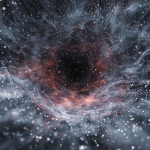If you step outside on a clear night, far away from city lights, you’ll see stars scattered across the blackness of space. But here’s the puzzle: if the universe is filled with stars, shouldn’t the night sky be glowing bright – completely covered in starlight, with no darkness at all?
This curious question is known as Olbers’ Paradox, and it has fascinated astronomers and philosophers for centuries. The answer extends beyond a mystery of light alone, and into the very nature of our expanding universe.
Olbers’ Paradox: The Classic Puzzle
In the 1800s, German astronomer Heinrich Wilhelm Olbers asked why the night sky is dark if the universe is infinite and full of stars. His reasoning went like this:
-
In an infinite universe, every line of sight should eventually land on the surface of a star.
-
If that’s true, then the night sky should be as bright as the surface of the Sun everywhere we look.
But it’s not. Instead, we see scattered stars against a backdrop of darkness. Why?
Solving the Paradox
Modern astronomy has solved the puzzle with three key insights:
1. The Universe Is Not Infinite in Age
The universe has not existed forever. Our current understanding is that it began about 13.8 billion years ago with the Big Bang (NASA). That jointly means the the universe – while unimaginably immense – has not been around forever, and yet is rapidly expanding. As a result, the observable universe is limited, meaning light from the most distant stars and galaxies hasn’t had enough time to reach us yet.
2. The Universe Is Expanding
Space itself is stretching, and as it expands, the light from distant galaxies is “redshifted,” stretched into longer wavelengths. Much of this light moves beyond the visible spectrum, into infrared and radio waves, which our eyes can’t see (ESA).
3. Stars Don’t Last Forever
Stars are born, live, and die. The universe isn’t filled with an eternal, uniform glow of stars – it’s full of galaxies where stars form and fade. This uneven distribution of starlight leaves dark spaces in between.
The Cosmic Glow We Do See
Although the sky is dark to our eyes, the universe does have a faint “background light.” The most famous is the cosmic microwave background (CMB), the leftover glow from the Big Bang itself. Invisible to human eyes, it fills the universe with a soft radiation in the microwave part of the spectrum (Planck Mission, ESA). Sensitive instruments can detect it, confirming that the early universe really was glowing everywhere.
Light Pollution vs. Natural Darkness
On Earth, the darkness of the night sky is also affected by light pollution. This effect comes from the artificial glow from streetlights, cars, sporting arenas, homes, and city buildings. In heavily populated areas, this makes it hard to see stars at all. That’s why astronomers treasure dark-sky preserves, where the natural darkness reveals thousands more stars.
Fascinating Facts About the Night Sky
-
A candle problem: In Olbers’ original paradox, the idea was like filling an infinite forest with trees – eventually, your view would be blocked everywhere. But the universe doesn’t work that way.
-
Cosmic background light: Besides the microwave background, astronomers have detected faint “extragalactic background light” from all the stars and galaxies that ever shone.
-
Not evenly bright: Even if the universe were infinite and static, galaxies and dust would absorb some light, changing the picture – but they’d also heat up and re-radiate it, so the sky would still glow to an extent.
-
Deep field images: The Hubble Space Telescope’s famous “Ultra Deep Field” photo shows that even tiny, “empty” patches of sky are full of distant galaxies.
-
Our eyes’ limits: Many stars and galaxies give off light too faint for us to see without telescopes, making the sky look darker than it actually is.
Questions to Ponder
-
If the universe had no beginning and no expansion, what would the night sky look like?
-
How does the finite speed of light shape what we see in the night sky today?
-
What does Olbers’ Paradox teach us about the importance of asking “simple” questions?
-
How might the night sky look different to a creature with eyes that can see infrared or radio waves?
-
Why is preserving dark skies on Earth important; not just for astronomy, but for ecosystems and human health?
The darkness of the night sky seems to be a simple about the absence of light, yet it provides fascinating evidence of the universe’s history, expansion, and finite age. Every time we gaze into that cosmic blackness, we’re looking at one of the most important clues to the story of everything.


